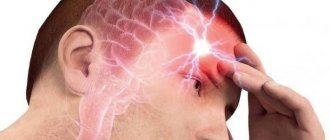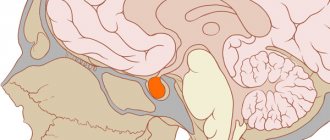Description of the disorder
Sleepwalking is not considered a separate disease; doctors classify it as a sleep disorder. Sleepwalking does not pose a threat to health; only the consequences of night walks are dangerous.
A sleepwalker is able not only to walk around the house, but also to perform actions that are difficult for an unconscious state. For example, dressing, drawing, eating food, etc. Nevertheless, walking in a dream can result in trauma both for the sleepwalker and for those around him. A somnambulist (or as a sleepwalker is also called) can trip and hit the floor, or go outside wearing what he slept in, or climb onto a windowsill, putting himself at risk of falling out of the window.
A sleepwalker in such a state cannot be woken up, and it is difficult to do so. Sleepwalking occurs in the slow phase , when sleep is deepest.
During night walks, a sleepwalker may break something, break something, or cut himself on something. Therefore, there should be no breakable or piercing objects in visible places in the house.
A rare case of sleepwalking is not a pathology if the frequency of sleepwalking is no more than 1 time per month. As a rule, if a sleep disorder occurs after drinking alcohol, this is not critical. It is important that attacks do not occur while sober.
According to a meta-analysis of studies, the average person experiences sleepwalking in any form at least once a year.
What does sleepwalking mean?
Sleepwalking is translated from Latin as “lunar madness.” Moonlight seemed something magical to people of the past. Therefore, when they saw a man walking in a dream under the full moon, they believed that he was controlled by the heavenly night body.
Modern somnologists call sleepwalking more scientifically - somnambulism, and the sleepwalker himself - a somnambulist. Somnambulism is literally translated from Latin as “walking in a dream” (“somnus” - sleep, “ambulo” - walking). Less commonly used is the term “ noctambulism ,” translated as “walking at night” (“noctis” in Latin - “night”).
Precautionary measures
In order to reduce the likelihood of sleepwalking, you must follow certain recommendations.
- Refuse to watch psycho-emotional TV shows and films, especially in the evening and at night.
- Take care of moderate physical activity throughout the day. In the evening, relieve yourself of such stress; it is better to take a walk in the park.
- Give up bad habits and haphazard use of medications. It is necessary to understand that taking certain medications can also develop sleepwalking.
- Follow the rules of healthy sleep. Monitor your circadian rhythms. Go to bed at the same time every day, recommended before 23:00. Remember to get at least eight hours of sleep.
- Don't forget to ventilate the room before going to bed.
- Consider relaxing activities. For example, you can resort to massage or taking a bath with aromatherapy, or yoga.
- Fighting stress. A person should understand that strong nervous tension often causes sleepwalking, so it is recommended that you learn to calm your nerves.
Now you know how to treat a person with somnambulism. You need to know that not every case requires urgent medical intervention. Remember the rules of behavior with an individual walking in their sleep, and do not forget about the likelihood of injury.
Causes of sleepwalking in adults
- Changes in hormonal levels. They are observed in adolescents during puberty, people with endocrine diseases, pregnant women and women during menstruation.
- Brain lesions. Traumatic brain injuries and neurological diseases often lead to the development of sleepwalking.
- Lack of sleep. A common cause of sleepwalking in adults.
- Mental disorders. Neuroses and hysterics can lead to sleepwalking in adults.
- Stress. Strong emotional experiences (loss of a loved one, divorce, career failures) can be associated with sleepwalking.
- Chronic diseases. Diabetes mellitus, asthma, epilepsy, Parkinson's disease and cardiovascular pathologies can cause sleepwalking.
- Sleep disorders. Sleepwalking has been linked to restless legs syndrome and sleep-disordered breathing.
- Overeating before bed. After a sweet meal, insulin is released into the blood, the excess of which can interfere with sleep.
- Overstimulation of the psyche in the evening. Watching action-packed films or YouTube videos can trigger sleepwalking and sleep talking.
- Alcohol intoxication. Alcoholic drinks also promote sleepwalking.
- Taking medications. Sleepwalking occurs when using psychotropic drugs and drugs that affect the brain.
For what reason does it occur?
Somnambulism is more often diagnosed in children, especially boys. The fact is that children are more emotional and impressionable. The loads placed on them in the modern world are considerable, which is why the child’s brain continues to be active at night, which provokes him to get out of bed. Sleepwalking in children can also be caused by:
- active pastime shortly before bedtime;
- conflicts between the child and parents;
- lack of a healthy climate in the family;
- sitting in front of the monitor in the evening.
The following factors can also provoke sleepwalking in children:
- epilepsy;
- heredity;
- migraine.
The main causes in adults include:
- epilepsy;
- severe stress;
- tumor in the brain;
- neurosis-like state;
- diabetes (mellitus);
- lack of sleep;
- panic attacks;
- Parkinson's disease;
- dementia;
- TBI;
- migraine;
- dysfunction of the cardiovascular system;
- cerebral aneurysm;
- apnea;
- poor nutrition, heavy dinner;
- pregnancy period;
- attack of bronchial asthma at night;
- taking drugs, alcohol;
- the use of medications that contribute to sleepwalking.
Signs of sleepwalking
- The man gets out of bed and sits on the edge for some time without getting up. As a rule, he then lies down and sleeps on. There may be several such rises during the night.
- The sleeper begins to get dressed at night, without reacting to the words of others. After getting dressed, the somnambulist can leave the house or try to do so. If the escape takes place, a person in a sleeping state can go far and fall asleep right on the street. In most cases, such cases of somnambulism end in injury.
- A man gets up and walks around the house at night. At the same time, he can talk to members of the household without realizing it. The sleepwalker's speech is slurred. The eyes may be open, but the gaze seems to be “glassy”, looking into nowhere.
- The sleeper talks in bed, then gets up and begins to walk around the room, continuing to conduct a monologue. It's difficult to understand what he's talking about. Doesn't respond to questions.
- The somnambulist falls asleep in one place in the house and wakes up in another. In the morning he does not remember how he ended up out of bed.
- A person with sleepwalking grinds his teeth, twitches his hands, clicks or smacks his lips. Often these manifestations indicate somnambulism.
By the way, constant fatigue in the morning can be a sign of sleepwalking in adults.
Sleepwalking in children: how to deal with it. Read more
Why is this happening
Scientists cannot yet give an exact answer to the question of what exactly neuropsychic processes cause people to walk in a sleepy state. We can only say that this disorder is provoked by incomplete awakening from the deep phase of slow-wave sleep. A person, at the moment of sleepwalking, has not yet fully woken up, but is no longer sleeping. His consciousness is confused, although he sees his surroundings well.
If a person has a predisposition to somnambulism, this does not mean that he will walk in his sleep. In order for the debut of sleepwalking to occur, predisposing factors are needed. The main causes of sleepwalking that contribute to its occurrence are the following:
- overstrain of the nervous system;
- experienced severe stress;
- chronic insomnia;
- taking certain medications (antidepressants, beta blockers, antipsychotics);
- diseases that directly or indirectly affect the quality and duration of sleep, as well as the state of the nervous system (reflux disease, Parkinson's, chronic depression, obstructive apnea, restless leg syndrome).
Important: under no circumstances should you wake up sleepwalkers while they are sleepwalking. This is especially not recommended if a person is in a dangerous situation, for example, walking along the edge of a roof. If you call him, he will wake up and probably fall - and then the consequences may be irreparable. In addition, a sleepwalker can be very frightened if he is awakened during his adventures. As a result, he will receive severe stress, which will only worsen the situation.
Alcoholic somnambulism
Sleepwalking after alcohol often occurs in cases where the dose drunk was rather large. It manifests itself not only by sleepwalking. A person in this state may shout excitedly, mutter to himself, or even try to fight with other people. After waking up, he most often does not remember anything. Usually, alcoholic sleepwalking goes away without a trace if you stop drinking alcohol.
Features of childhood somnambulism
Sleepwalking in children has almost the same causes, symptoms and treatment as in adults. But it occurs much more often, since a child’s unformed psyche is less resistant to various negative influences. The following factors can provoke the debut of sleepwalking in a baby:
- long-term illness causing weakened immunity;
- unfavorable moral atmosphere in the family (frequent conflicts, divorce of parents);
- problematic situations at school, because of which the child is very worried;
- chronic lack of sleep as a result of non-compliance with the daily routine.
In most cases, sleepwalking in children is a random episode and disappears without a trace as soon as the causes that caused it are eliminated. But if the impact of an unfavorable factor is long-lasting, the tendency to sleepwalk can take hold and remain for many years. Therefore, a child suffering from somnambulism should be shown to a doctor immediately.
Types of sleepwalking
Alcoholic
Appears after drinking large quantities of alcohol. Strong drinks affect the brain, leading to sleepwalking a couple of hours after falling asleep. Alcoholic sleepwalking is not associated with other types of sleepwalking. You can get rid of it if you reduce the amount of alcohol you consume or completely give up strong drinks.
Sexual
A sleepwalker may unknowingly exhibit sexual activity. Experts call this disorder sexsomnia . It is often associated with mental disorders or neurological diseases. After an episode of sexsomnia, a person usually does not remember what happened. His brain perceives nighttime sexual activity as an erotic dream.
The person with whom the sleepwalker shares a bed suffers more from sexual sleepwalking. This form of somnambulism must be treated by a specialist.
Sexsomnia affects both men and women equally.
Talking in your sleep
Talking in your sleep or somniloquy can also be considered a manifestation of sleepwalking. Sleep talk most often occurs during REM sleep. While nocturnal adventures appear in the deep or slow phase.
In a dream, a person speaks indistinctly, only occasionally pronouncing articulate sentences. Somniloquy is more common in children. Adults talk less often in their sleep.
Sleep talkativeness usually does not require treatment. The help of a specialist is appropriate only in extreme cases.
A child talks in his sleep - what to do? Read the article
Night eating syndrome
The disorder is characterized by the fact that the sleeper goes to the kitchen and eats whatever comes to hand. Despite the apparent harmlessness, a somnambulist in this state can absorb inedible objects. For example, washing powder, dishwashing gel or food along with packaging.
It’s even more dangerous when a sleepwalker wants to turn on the gas stove and try to cook something.
How does it manifest itself?
Research has shown that sleepwalking is a fairly common phenomenon. At least 5% of people have had an episode of sleepwalking at least once in their lives. In childhood it occurs approximately four times more often than in adults. The degree of its manifestation may vary. Some people sleepwalk at least once every few weeks, while others experience it every night.
It is wrong to think that sleepwalkers move like zombies, with their eyes closed, with their arms extended forward, not seeing anything in front of them. In fact, they walk with their eyes open, and from the outside they may appear to be awake. Upon awakening, the sleepwalker is even able to partially remember how he wandered in his sleep and what he did. But he will think that he dreamed it all.
Somnambulism can occur not only at night. At night, its episodes occur more often only for the reason that daytime sleep is usually short and not very deep. If a sleepwalker falls asleep during the day, sleeps for several hours and enters the deep sleep phase, he may well experience another episode of sleepwalking.
How to get rid of sleepwalking: treatment plan
You need to fight sleepwalking after finding out its cause. And to determine it, you should visit a doctor.
If, apart from somnambulism, there are no visible diseases, it is first better to consult a psychotherapist . The specialist will ask several questions, the answers to which will help identify possible mental disorders. Also, the doctor should ask about any medications you are taking that may be causing sleepwalking.
At your doctor’s appointment, tell us how long ago sleepwalking was discovered. If you suspect one of the reasons described in the article, also tell a specialist about it.
After the appointment, the doctor can refer the patient for diagnostics. Often this means taking a general blood test, checking sex hormones, thyroid hormones, and an MRI or CT scan of the brain.
If diseases are detected that affect the development of somnambulism, doctors prescribe specific examinations. Among them: EEG - electroencephalography, ultrasound of cerebral vessels, diagnostics of the endocrine system, etc.
Sleepwalking in adults is rarely associated with serious illness. Therefore, sleepwalking is treated mainly by a psychotherapist.
To get rid of night walks in your sleep, antidepressants, antiepileptics and sleeping pills are prescribed. Additionally, psychoanalysis, hypnotherapy, electroconvulsive therapy, play therapy, etc. are used.
Somnambulism, especially in adolescence, often goes away on its own and does not require treatment. Trying to correct the situation without the participation of a doctor is risky. Sleepwalking may be associated with diseases of the nervous or endocrine system. Therefore, it is prohibited to prescribe medications or engage in therapeutic measures without a specialist .
Treatment with tablets
In some cases, medications help get rid of sleepwalking. They are prescribed when sleepwalking becomes dangerous for the somnambulist and those around him.
To treat sleepwalking, the doctor prescribes antidepressants, benzodiazepines (eg Phenazepam), antiepileptic drugs, tranquilizers, and antipsychotic drugs. All of them reduce brain activity, thereby reducing the likelihood of sleepwalking.
Drugs for the treatment of somnambulism are prescribed exclusively by a doctor. Self-use of such products can be harmful to health.
Buy medicines at low prices on Zdravcity
How to deal with sleepwalking without pills
You can get rid of sleepwalking using the method of warning awakenings. To do this, the somnambulist is woken up 20 minutes before the expected sleepwalking and is not allowed to sleep for some time. This method seems to reset the sleepwalker’s sleep, which reduces the risk of sleepwalking. This method needs to be used for a long time.
The wake-up method is inconvenient for household members who will regularly wake up in the middle of the night and wake up the sleepwalker. Few people will want to wake up every night at a certain time in order to fulfill the conditions of the method.
How to treat sleepwalking with folk remedies
To get rid of somnambulism, you can try traditional methods of treatment. And you should start by taking sedative herbs. Before going to bed, it is recommended to drink tea with sage, St. John's wort, mint or lemon balm.
In addition, closer to bedtime, you can take baths with essential oils, which include sedative herbs. If you don't want to take a full bath, you can immerse only your feet in the bath. For a therapeutic effect, take a bath for 10 minutes.
To some extent, meditation and yoga can be classified as folk methods of treating sleepwalking. Spiritual practices allow you to combat stress, a common cause of somnambulism.
The official Ascona website offers mattresses with a 50% discount. View assortment
Diagnosis of sleepwalking
If an episode of sleepwalking occurs for the first time, and you can associate it with a stressful situation experienced the day before or overwork, then you can postpone seeking medical help. In the case when such episodes are repeated repeatedly, you should still seek help from a neurologist, neuropsychiatrist or psychiatrist to establish the cause of these phenomena.
To help a specialist make a diagnosis, you or your relatives should:
- note on paper the time of falling asleep, after what time the episode of sleepwalking begins, how long it lasts, the patient’s behavior during this period, morning awakening;
- think over and note the reasons that could provoke somnambulism (listed at the beginning of the article);
- make a list of the most commonly eaten foods and regularly taken medications.
When going to the reception, it is very advisable to take with you a witness to your nightly “travels”.
The doctor will talk with the patient, ask him a number of necessary questions, conduct an objective examination and prescribe additional research methods that confirm or refute the diagnosis. Typically, such studies are:
- electroencephalography (determining the electrical activity of the brain; it is this method that allows diagnosing the presence of epileptic foci in the brain);
- polysomnography (the patient spends the night in a special sleep laboratory, where, before falling asleep, sensors will be connected to him and changes occurring in the nervous system during sleep will be monitored);
- ultrasound examination of cerebral vessels (will determine the nature of blood flow in them);
- computed tomography or magnetic resonance imaging (will detect neoplasms, if any, or changes of any other nature);
- consultations with related specialists (endocrinologist, cardiologist, pulmonologist) for the diagnosis of somatic diseases that could provoke the development of sleepwalking.
Consequences of sleepwalking
The results of sleepwalking can be:
- Injuries. Moreover, serious ones, for example, concussions, broken bones, facial injuries, etc.
- Daytime sleepiness. Sleepwalking prevents you from getting a good night's sleep, which causes your performance to deteriorate.
- Deterioration of relationships with household members. By getting up at night and walking around the room, the sleepwalker disturbs the sleep of the people living with him. On this basis, relationships between cohabitants can deteriorate.
How to avoid injuries when sleepwalking
- A person with sleepwalking must sleep in complete darkness. Nightlights or street lamps increase the risk of sleepwalking in adults. To reduce illumination in the room, hang thick curtains in the bedroom, remove all night lamps from the room, and turn off the TV and computer before going to bed.
- A somnambulist should not sleep in a room alone. If something happens, a nearby person will direct the sleepwalker to bed, which will prevent injury.
- Bedroom windows should be closed at night, even if it is warm outside. This will protect a person from accidentally falling out of the window. In order not to close the windows in the summer, you can put bars on them. This will completely eliminate accidents.
- It is necessary to remove from the bedroom all piercing and cutting objects and things that pose a health hazard.
- You should collect scattered wires on the floor if they are carelessly stretched throughout the room.
- It is also better to hide the keys from visible places so that the sleepwalker does not suddenly leave the house.
- Place a wet rag in front of the person's bed, right in the place where the sleepwalker should stand. It is assumed that after standing on the rag, the somnambulist will immediately wake up and then go back to bed.
- It is recommended for a somnambulist to set an alarm every 1.5 hours of sleep in order to “reset” the sleep cycle. Human sleep consists of cycles, which in turn consist of slow and fast sleep phases. By waking up in the intervals between cycles, a person can control the onset of sleepwalking. The disadvantages of the method are constant drowsiness and difficulty falling asleep at night after the first sleep cycle.
- Since sleepwalking can be caused by watching shocking content, it is best to limit your consumption before bed.
When does sleepwalking occur?
As you know, sleep includes 2 phases: slow and fast. The slow-wave sleep phase consists of 4 stages - from falling asleep to deep sleep. The REM sleep phase is accompanied by active movements of the eyeballs; it is during this phase that a person dreams. The sleep cycle, which includes 2 large phases, lasts on average 90-100 minutes and is repeated up to 10 times during the night. Sleepwalking usually occurs during the deep sleep phase (that is, at the end of the 1st phase) of the first or second cycles. During the day, somnambulism occurs extremely rarely, since the duration of daytime sleep is insufficient.
In young children, the slow-wave sleep phase is longer and the sleep in this phase is deeper than in adults: these features also increase the likelihood of them developing sleepwalking.
As for physiology, sleepwalking occurs when, during sleep, inhibition of the functions of the central nervous system does not extend to the areas of the brain responsible for motor functions. That is, the overwhelming number of body functions are inhibited, but the movement function is not.
Do they take you into the army with sleepwalking?
If sleepwalking is a consequence of serious chronic illnesses, the young man is not fit for military service. The conscript is issued a military ID with fitness category “B” or “D”.
Diseases associated with sleepwalking and exempt from conscription include:
- epilepsy,
- bronchial asthma,
- diabetes,
- endocrine pathologies with serious consequences for the body,
- mental and neurological diseases,
- cardiovascular diseases, etc.
In other cases, when sleepwalking is not caused by chronic diseases, the young man is fit for service in the armed forces .
The list of illnesses for conscripts does not include somnambulism. Therefore, it is problematic to free yourself in the presence of sleepwalking alone.
It happens that sleepwalking catches a person already in the service. In this case, he is sent to the hospital for examination. If a serious illness is unexpectedly discovered that leads to sleepwalking, the soldier must be discharged.
Sleepwalking, somnambulism, classification, types, forms
Neurologists, neuropathologists, reflexologists, reflexologists, psychiatrists distinguish 2 main types (forms) of somnambulism - neurotic somnambulism and neurosis-like somnambulism. In our practice, we have encountered cases of sleepwalking that occurred without provoking factors or somatoneurological disorders. The mechanism of development of somnambulism is closely related to the characteristics of the sleep-wake cycle. Sleepwalking often occurs in stages 3 and 4 of non-REM sleep and is caused by dysfunction of the ascending systems of the brain.
Prevention
To prevent sleepwalking in an adult, you should adhere to the following tips:
- Find a way to reduce the impact of stress on your body. It is difficult to completely protect yourself from stress, but doing something you love can distract you from problems. Sports training, meetings with friends, yoga and breathing practices are suitable as an anti-stress activity (link, article).
- Get plenty of rest. Set aside 1 hour of quiet time every day before bed. You can relax with a book or through meditation.
- Maintain a sleep-wake schedule. It is very difficult to prevent, let alone cure, sleepwalking without normalizing sleep. Therefore, you need to go to bed and wake up at the same time.
- Avoid watching action-packed films, entertaining videos and computer games before bed. Such pastime stimulates the brain, which is why sleepwalking occurs.
- Sleep at least 7-8 hours a day. With normal sleep duration, the risk of developing sleepwalking is reduced.
- Don't drink coffee or strong tea before bed. The caffeine in these drinks stimulates the nervous system and increases the risk of somnambulism in adults.
- Don't smoke or drink alcohol in the evening. It is better to give up cigarettes altogether. Tobacco is very harmful to health. But drinking alcohol can lead to alcoholic sleepwalking, when the functioning of the brain is disrupted under the influence of strong drinks. The result is “drunken” sleepwalking.
- Don't overdo it with physical activity before bed. Sports activities 1-2 hours before going to bed again stimulate the nervous system and provoke sleepwalking. It is best to stop sports activity 3-4 hours before bedtime.
Principles of treatment of somnambulism
Getting enough sleep and avoiding active games before falling asleep will help in the treatment of sleepwalking.
In most children, this disorder goes away on its own as the child grows older.
If sleepwalking occurs infrequently and no pathological changes in the body have been identified, treatment consists of lifestyle modification, namely minimizing the impact of risk factors:
- regular, long (7-8 hours) night sleep;
- before bed – a relaxing ritual (for example, you can take a warm bath with relaxing oils, listen to calm music, have a soothing massage, drink mint tea, etc.);
- Avoid watching TV and working on the computer at least 2 hours before bedtime;
- eliminate alcohol consumption;
- avoid stress at work and at home, and if it happens, then try not to bring it into the house, but, so to speak, leave it at the door;
- if a child suffers from sleepwalking, then it is necessary to ensure that he adheres to the daily routine; make sure he sleeps enough to get enough sleep; limit watching TV and playing on the computer, before going to bed do not play active games, but play calm ones (for example, board games), draw, read a book or listen to pleasant music.
If the cause of sleepwalking is any medications taken by the patient, they should be discontinued or at least the dosage reduced.
If sleepwalking occurs against the background of epilepsy, the patient will be prescribed antiepileptic drugs, and when the cause is neurosis, tranquilizers and antidepressants.
If the disease is not of a neurological nature, the disease that caused it is treated (for arrhythmia, antiarrhythmics are prescribed, for diabetes mellitus, adequate hypoglycemic therapy, and so on).
If, even during treatment of underlying diseases, episodes of sleepwalking do not stop, disrupting the patient’s daily activity, and there is a risk of injury during this time, the patient may be prescribed medications that affect sleep phases. They are prescribed in low doses, the duration of treatment is from 3 to 6 weeks.
You should not wake up a somnambulist during the period of sleepwalking - this can frighten him, provoking the development of other mental disorders. You should calmly take him by the hand or shoulders and, speaking in a quiet voice, lead him into the room and put him to bed.
Sometimes psychiatrists and psychotherapists use hypnosis as a method of treating sleepwalking.
FAQ
Can a sleepwalker perform complex actions? For example, play the guitar, pour yourself some tea, etc.?
This happens extremely rarely. Basically, the somnambulist is very simple in his actions. A common option is when a person gets out of bed, sits on it for a while, then lies down again. At this time, he can say several difficult-to-understand phrases. At the same time, the sleepwalker will not respond to questions.
Why can't you wake up a person with sleepwalking?
The sudden awakening of a sleepwalker during sleepwalking can be very frightening. In an adult, this can lead to psychosis, panic and even a heart attack. In practice, it is difficult to wake a person in such a state.
A sleepwalker can wake up due to an injury received during night walks around the house. It is impossible to reduce the risk of injury by 100%, even by removing all dangerous objects from sight.
How dangerous is sleepwalking?
Every 4th episode of somnambulism is associated with trauma. Hitting your head during sleepwalking is common. But cases when a sleeper goes out onto the balcony and falls out of an open window are rare. However, to protect the somnambulist, the balconies in the house must be glazed, and the windows must be closed at night.
Does a person always wake up in bed after sleepwalking?
If a person begins to walk around the apartment, he most likely will not return to bed without outside help. A sleepwalker will most likely fall asleep on the floor.
Is sleepwalking associated with the full moon?
The connection between these things is indirect, but quite scientifically justified. Moonlight enters the bedroom, thereby increasing the illumination of the room. Bright light reduces the level of the sleep hormone in the brain, and the latter, in turn, gives the command to the whole body to wake up. However, the lighting in the room is not enough to wake you up completely. Because of this, a person goes into a borderline state - he seems to be sleeping, but he seems not.
We can say that sleepwalking is less associated with moonlight, but with the lighting of the bedroom as a whole. Therefore, sleepy walks around the house can be triggered by leaving the TV or night lamp on at night.
Is sleepwalking treatable in adults?
There is no 100% way to get rid of sleepwalking. However, if you follow all the doctor’s instructions, lead a healthy lifestyle and eliminate factors that provoke the disorder, the likelihood of sleepwalking will be almost zero.
Is sleepwalking associated with psychosomatics?
Considering that psychosomatic diseases are more often caused by mental disorders, sleepwalking is partly a psychosomatic sleep disorder. For example, chronic stress is the cause of somnambulism, and stress in this case is a mental disorder that provokes a psychosomatic disorder - sleepwalking.
Is sleepwalking inherited?
Yes. There really is a genetic predisposition to somnambulism. Canadian scientists proved this in 2011. In the study, experts found that in children with sleepwalking, parents often suffered from this sleep disorder.
I'm sleepwalking, does that mean I'm mentally ill?
There is no direct connection between sleepwalking and mental disorders. Somnambulism is a sleep disorder that has many causes. In some cases, sleepwalking is not at all connected with the human psyche.
Which doctor treats sleepwalking?
The problem of somnambulism is dealt with by somnologists, neurologists, and psychotherapists.
Is walking at night associated with epilepsy?
Doctors say there is a connection. However, sleepwalking in this case is a consequence of epilepsy. But sleepwalking in itself cannot provoke seizures.
Is it possible to remember what happens during sleepwalking?
This practice exists, it is called lucid dreaming. In this state, a person sleeps, while realizing that he is in a dream. And this makes it possible to control your sleep. To master this ability, you need to study the relevant literature and practice a lot. Traditional medicine practitioners are skeptical about lucid dreaming and lucid sleepwalking.
Should sleepwalking be treated?
In most cases, somnambulism goes away on its own, for example, when there are no serious reasons for its occurrence. But sleepwalking caused by neurological diseases or hormonal disorders must be treated.
Doctors' opinion
In order to get rid of sleepwalking, first of all, doctors recommend eliminating possible stress factors. To protect the patient during night travel, you should not try to wake him up by force. It is best to calmly approach, take his hand and try to put him back to bed. As a rule, sleepwalkers do not show aggression or resistance. As a preventative measure, you can place a wet towel near the bed. When the sleepwalker touches the cold surface with his bare feet, he will wake up. Such a person needs control, which is why the care and attention of loved ones is so important for a sleepwalker.
Interesting Facts
In the USA, Ron Whitehall, while sleeping, began to strangle his wife sleeping next to him. It turned out that at that moment the man was having a dream where he was attacking a snake. Fortunately, this episode of sleepwalking ended favorably. The wife remained alive.
Russian scientist L. Vasiliev believed that stories about the brownie appeared because of people with somnambulism. In his opinion, people perceived the noise coming from sleepwalkers as the antics of mystical creatures.
Several murders were committed while sleepwalking. In 1845, American Albert Tyrell killed his mistress with a straight razor and tried to set her house on fire. Moreover, he did all this unconsciously. The morning after this incident, the man woke up in his own bed covered in blood. At least that's what Tyrell claimed. The killer learned about the committed act from a newspaper. It is noteworthy that the jury acquitted Albert. Perhaps the acquittal was influenced by the fact that Tyrell was an official.
A similar murder occurred in 1985 in Canada. Kenneth Parks, while sleeping, got out of bed, got dressed and headed to his mother-in-law's house. After breaking down the door, Kenneth went up to the bedroom and began beating the woman until she died. The father-in-law sleeping next to him also got it, and Parks began to choke him. The man lost consciousness but survived. The killer surrendered to the police, but the court initially did not acquit Kenneth. Only after 3 years in prison was Parks released. Lawyers were able to prove that the murder was completely asleep. Psychologists who worked with Kenneth found out that this incident was a consequence of his dismissal from work, which occurred the day before the crime.
A case of sexual sleepwalking occurred in the Canadian city of Toronto. The guy drank alcohol at a house party and fell asleep on the couch. At the end of the festivities, the guests went to their rooms, leaving the young man on the sofa. In the morning, his friends woke him up and told him that he had raped one of the girls who came to the party. The guy didn’t believe this and replied that he didn’t remember anything about what happened that night. The case went to trial, but the young man was acquitted.
Sleepwalking test
How many hours a day do you sleep?
- More than 5 hours (1 point);
- Less than 5 hours (2 points);
- Less than 3 hours (3 points);
How many times do you wake up during the night?
- I don’t wake up at night (1 point);
- 1-2 times (2 points);
- More than 3 times per night (3 points);
How do you feel in the morning?
- Full of energy (1 point);
- There is slight drowsiness that goes away after a while (2 points)
- Drowsiness persists for more than 2 hours (3 points)
Are you experiencing the following sleep disorders?
- Insomnia (1 point);
- Talking in your sleep (2 points);
- Both options (3 points);
Did your close relatives (brothers, sisters, parents) suffer from sleepwalking as adults?
- No (1 point);
- I don't know (2 points);
- Yes, there were cases (3 points).
Interpretation of test results:
From 5 to 8 points – the likelihood of developing sleepwalking is extremely low.
From 9 to 12 points - there is a risk that you get out of bed at night.
From 13 to 15 points - most likely, episodes of sleepwalking appear with regular frequency.
Diagnostics
A person suffering from somnambulism may not even be aware of his problem for a long time. Most often, a sleepwalker learns that he walks in his sleep from close relatives. Or from neighbors who witnessed his nightly forays into the street. However, it also happens that a person suddenly wakes up during sleepwalking, sees himself in an incomprehensible situation, and begins to realize what is happening.
It is possible to diagnose the tendency of a child or adult to somnambulism using polysomnography. This is a special procedure that allows you to study a patient’s sleep using computer technology. As a result of the examination, an experienced doctor can determine not only how prone a person is to sleepwalking, but also the reasons that caused it.
As a rule, the EEG of sleepwalkers shows frequent, short-lived awakenings during the slow-wave sleep phase. At these moments, their consciousness is unclear, which is a sign of a change in the reactivity of the cerebral cortex. In this case, an episode of sleepwalking does not necessarily occur, but it is quite possible.
How to induce sleepwalking for diagnostic purposes
A person’s predisposition to somnambulism can be determined using specially provoked insomnia that lasts longer than a day. Healthy people sleep long and soundly after prolonged sleep deprivation. Their deep sleep phase turns out to be longer than usual.
In such circumstances, on the contrary, a sleepwalker’s sleep is disturbed, becomes intermittent and restless. He will often wake up, then fall asleep again. Artificially induced long-term sleep deprivation can even provoke a significantly increased frequency of sleepwalking episodes.
What is the danger of sleepwalking?
It is not always the case that sleepwalkers try to climb out of a window or walk along the edge of a roof. Most often, their actions are completely harmless both for themselves and for others. There are cases when people in this state successfully prepared dinner, played music on the piano, and even drove a car along a familiar route.
But, unfortunately, not all sleepwalkers' walks end happily. After all, they do not realize what is happening and do not see the danger in front of them. While sleepwalking, a person can fall out of a window, go out onto the roadway and get hit by a car, turn a pot of boiling water over on themselves, or get injured with a sharp object.
Therefore, in no case should you treat somnambulism as a funny and harmless disorder, hoping that it will someday go away. If an episode of sleepwalking occurs at least twice, you should urgently consult an experienced doctor. The specialist will conduct all the necessary examinations and advise how to get rid of sleepwalking.











